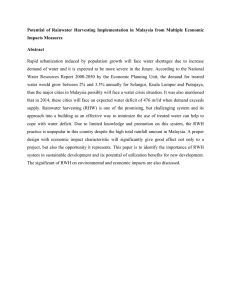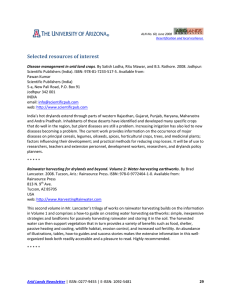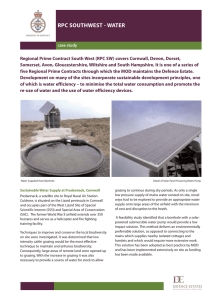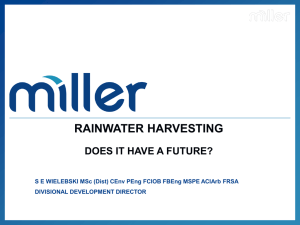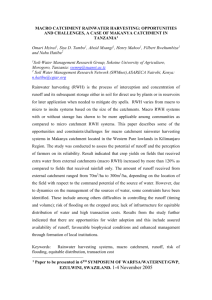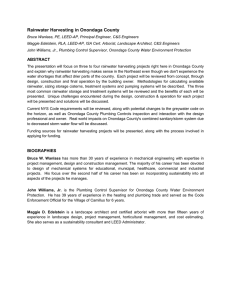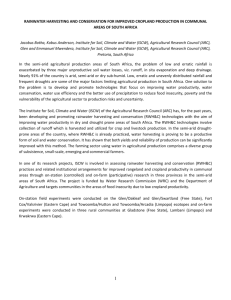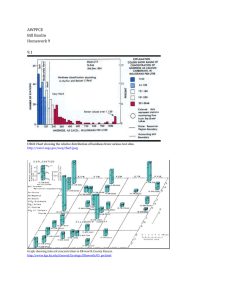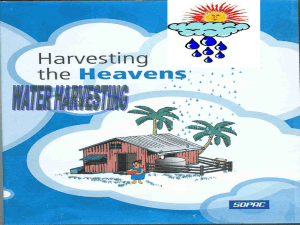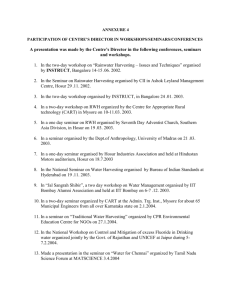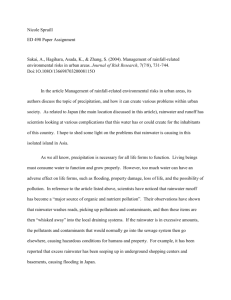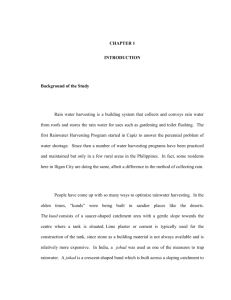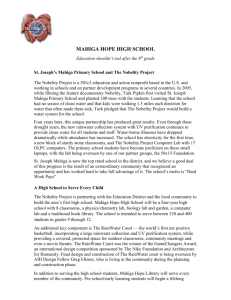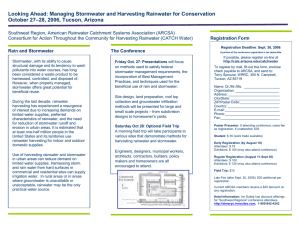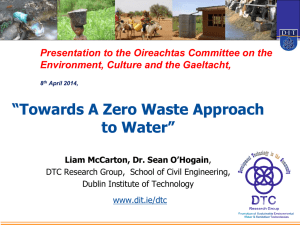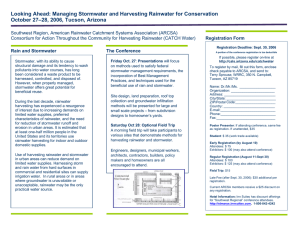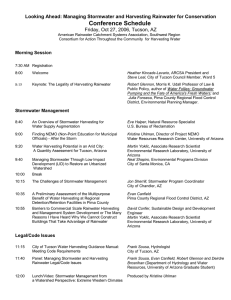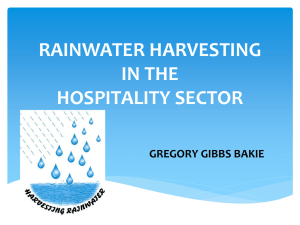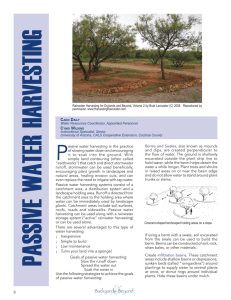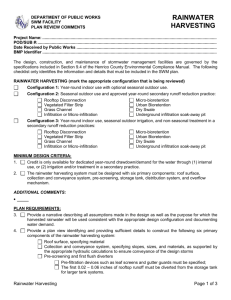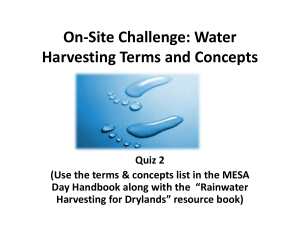David Butler (London - final)
advertisement
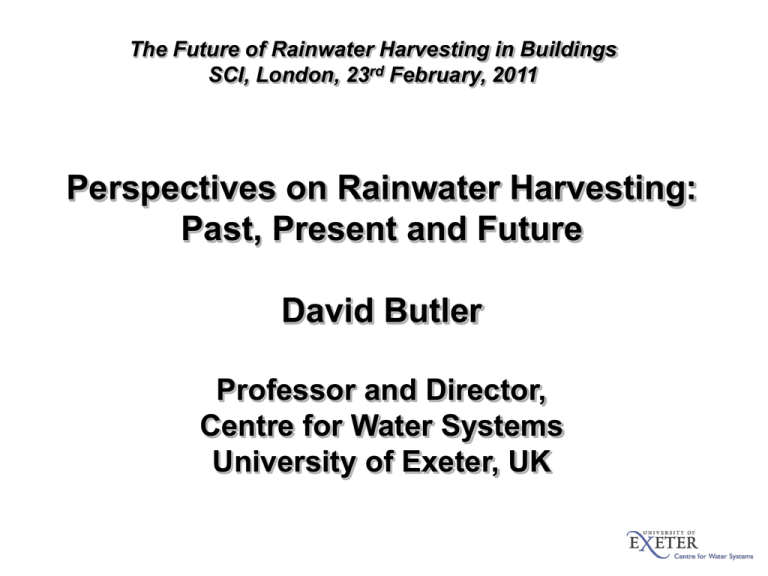
The Future of Rainwater Harvesting in Buildings SCI, London, 23rd February, 2011 Perspectives on Rainwater Harvesting: Past, Present and Future David Butler Professor and Director, Centre for Water Systems University of Exeter, UK Outline • • • • • Past Present Future What needs to be done? Conclusions Past • By no means a modern idea! • Simple concept based on local storage and use • Systems found in: – Israel, Africa, India, 2000BC – Mediterranean area, 1700BC – Petra, Jordan Past Rain was an important source of water in the ancient trading city of Petra, Jordan, which supported a population of 20,000 in a place where just 150 mm of rain fell a year. Present • Present day RWH remains a simple concept • System Components – Catchment – Collection system (First flush diverter?) – Treatment (Filter?) – Storage – Pump Present Indirectly pumped Present FILTER/SCREEN SUPPLY PUMP 100% OVERFLOW SEWER Directly Pumped Present Innovation Building, University of Exeter Present BedZed, London Present • Benefits: – Saves potable water (by displacing nonpotable water use) – Saves energy/carbon (at least that associated with the displaced water) – Reduces flood risk (especially summer storms & can be enhanced by better design) – Reduces load on regional water resources and central water infrastructure (and potentially delays/limits expansion) Present Saves potable water (by displacing nonpotable water use) Present Reduces flood risk (especially summer storms & can be enhanced by better design) Present • Drawbacks: – Requires maintenance (to ensure reliability) – Requires energy/carbon to construct and operate (at least most current systems) – Has potential water quality issues (although these are minimised by careful design/installation) – Payback period depends on scale of provision (shorter in bigger buildings) – Owners may be unfamiliar and misuse or remove system Future MAINS TOP UP CROSS FLOW FILTER OVER FLOW CISTERN SUPPLY SEWER/DRAIN Gravity Feed Systems Future Rainwaterhogs are modular, DIY, expandable, reusable, and recycled storage units that can be connected to create a custom system placed at several different locations throughout the property. Future Dwr Cymru/Welsh Water, consultants MWH and manufacturer Aqualogic are working to produce affordable wall-mounted rainwater harvesting systems Future 90-120L To supply (WCs) • Rainsense is a prototype, patented system that uses tiled gullies to collect runoff part way down the roof and stores the rainwater in modular, storage tanks in the eaves space – then supplies the harvested rainwater via gravity Future The CISTA rainwater harvesting system provides storage for rainwater within a vertical planted frame, allowing conservation of water and increased green space. Future BabyGROW is a prototype planted water recycling system for collection & treatment of grey and/or rainwater to improve water quality and provide increased green space Future Personal rain saver? What needs to be done? • New RWH designs, especially for domestic dwellings. Need to: – be easily retrofitable – make better use of space for water storage – reduce or eliminate the need for fossil-derived energy for pumping – be reliable, easy to use and maintain. What needs to be done? • New RWH designs need to be multi-functional to: – supply in-building water needs – provide flood protection – improve water quality – provide a greener environment and – use less embedded carbon. What needs to be done? • New business models: – consider system leases from a supplier or water company – mitigates the capital cost to user – saves money for the householder – ensures regular maintenance – provides a profit opportunity for the provider. What needs to be done? • Improved governance of emerging approaches at institutional level: – to help lead the way forward – to integrate them into everyday thinking – by providing authoritative advice and leadership. What needs to be done? • Increased public awareness and acceptability by: – Better best practice guidance – Incentives and grants – Exemplars of successful approaches – Identification of ‘trusted’ sources – ‘mainstreaming’. Conclusions • RWH systems are currently appropriate and viable at large building scale • New RWH technologies are emerging for retrofit in domestic dwellings where there is greatest need and potential benefit • Creativity and commitment needed on ownership and reliability. The Future of Rainwater Harvesting in Buildings SCI, London, 23rd February, 2011 Perspectives on Rainwater Harvesting: Past, Present and Future David Butler d.butler@exeter.ac.uk Thanks to Alan Fewkes & Sarah Ward for some of the slides used in this presentation
